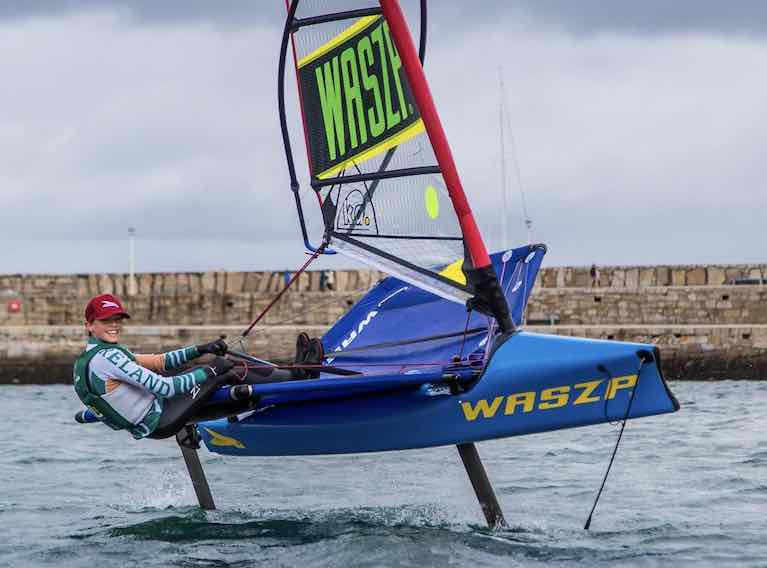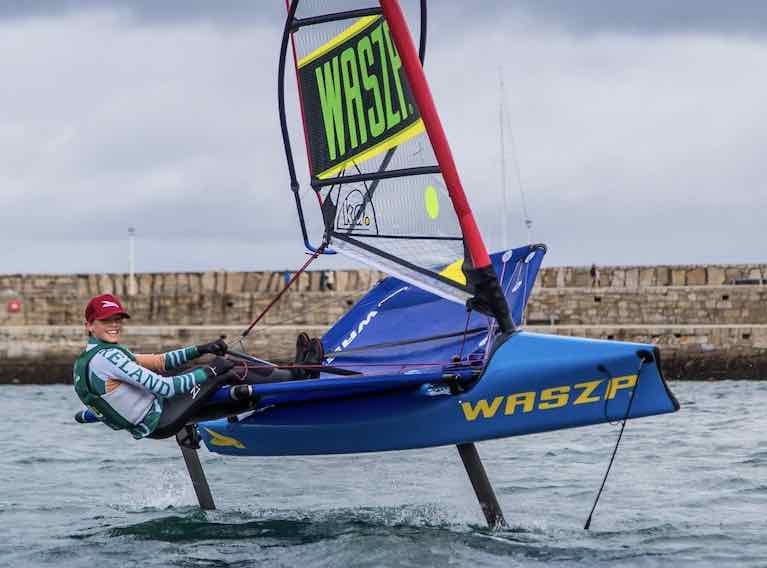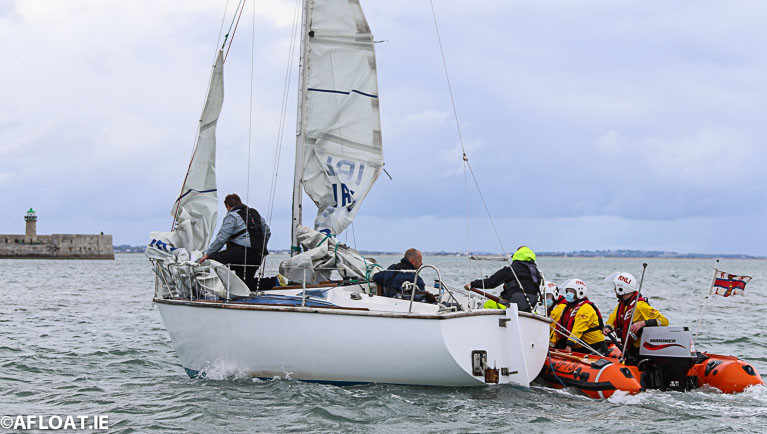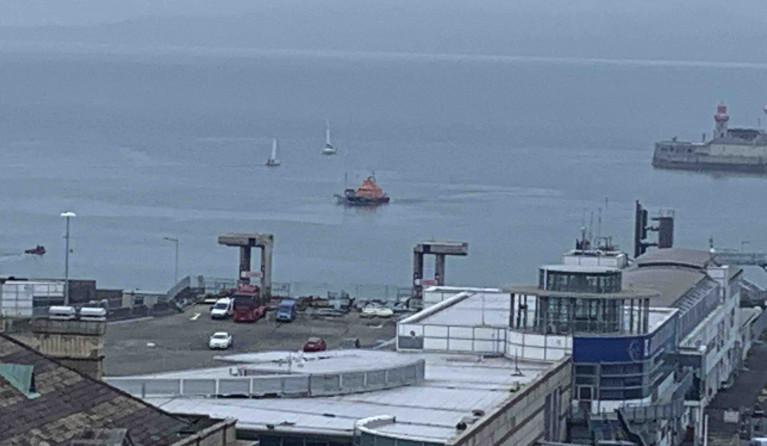Displaying items by tag: Dun Laoghaire Harbour
Charlie Cullen Just Pipped for WASZP Big Prize
Irish WASZP youth sailor Charlie Cullen was pipped by an Australian Olympic sailor for first prize in last weekend's climax of the Global GPS Racing Dinghy Series.
The Dun Laoghaire Harbour skiff sailor was in pole position to win the first prize of two spectator tickets to a Sail GP event and a ride on an F50 catamaran but canny Australian Brad Devine pipped him to the post right on the event deadline.
The first-year Trinity College Dublin Engineering student made a real stab of juggling his studies and the big waves on Dublin Bay to try and win the world challenge and very nearly did.
More here
Dun Laoghaire Harbour Laser Dinghy Class Thank DBSC Race Officer Team
It’s no secret that the Dun Laoghaire Harbour Laser fleet is in good shape. Anybody strolling the piers or looking out on club forecourts will have seen that for themselves. DBSC (Dublin Bay Sailing Club) in 2020 drew a huge entry of 92 Laser 4.7s, Radials and Standards, with regular turnouts of 60-70 boats, with sailors of all ages. Likewise, numerous pods go out training once or twice a week, sharpening race skills and getting newer or returning sailors up to scratch for the real deal.
Everybody in this local Laser community just gets on with it in a great spirit of co-operation and camaraderie. We will get the sailors on the water for racing, but that’s where experienced DBSC Race Officer Suzanne McGarry steps in, aided by a wonderful flagship team. DBSC delivered a wonderful programme from late June to mid September, despite all the challenges of this annus horribilis. Until Level 3 kicked in, organizers squeezed in 24 great Saturday Laser races, as well as a comprehensive Tuesday night series. The funny thing now as we all reflect is that many of us can’t remember a more enjoyable sailing season, even with no showers, outdoor changing at times and all the very necessary protocols. I suppose it was all about local sailing again and people got into a really nice rhythm, uninterrupted by regattas, Championships or foreign holidays! The class captains for the last six years were, therefore, delighted to meet Suzanne at the RStGYC yesterday to present a token of our appreciation for her and the whole team. She went to great lengths to explain about the importance and dedication of everybody involved in the race management team and it’s striking so many have worked together for so many years.
It was in 2015 that Lasers really came out from the shadows in Dun Laoghaire after the fleet had dwindled to 3 or 4 stalwarts, by then subsumed into the Mixed PY division. DBSC had the foresight to listen, giving us our own class again, more shorter races and low entry fees (especially for Under 25s). We were immediately up over 30 boats by 2015 and we’ve basically added 10 regular racers each season since then, even more this year with the push into solo sailing.
 Tuesday DBSC night Laser racing in 2020 Photo: Rob Walker
Tuesday DBSC night Laser racing in 2020 Photo: Rob Walker
Excellent race management has been a massive contribution to the growth of the class. We estimate that Suzanne has presided over more than 80% of the hundreds of races staged in the last six years. Start lines are square, beats and runs are true and results are gathered efficiently. But remember, we’re talking about very tricky conditions here. Racing is within the shifty confines of our wonderful harbour, or outside in Scotsman’s Bay, often in a fickle evening breeze, with a strong tide. Despite being in that characteristic, steely “zone” up on the foredeck, Suzanne is very approachable and receptive to feedback onshore. Indeed, this season, after only a few races, she quickly introduced an innovative tweak to the starting procedure, to give the big Radial fleet more time to digest course changes between races. Incidentally, the 53 boat Laser Radial entry is almost definitely the largest local racing Radial fleet in the world, just now.

The 2020 season was an amazing effort by all DBSC Officers and volunteers. Suzanne and her team got dinghies out competing on June 30th as Afloat reported here. This was at the earliest possible opportunity given government guidelines and well before DBSC keelboat racing started.
Undoubtedly, the Laser turnout that day of 60 boats was the biggest one-design racing staged anywhere in Ireland since the Pandemic began. We hope we encouraged others up and down the country.
From all Dun Laoghaire Laser sailors, thank you, Suzanne and colleagues, for all your support and service down the years.
Below are the names of the core people who help Suzanne and keep the show on the road;
Barbara Conway. Ros Bremner. Caroline Liddy. Brendan Dalton, Declan Traynor, Dara Traynor, James Traynor, Dave Coleman, Liz Aylmer, Sharon Moylan, Ian Mathews, Ben Mulligan, Niki Wheatley, Susan Spain, Caitriona O’Brien Michael Costelloe and Joanne Sheehan
Dun Laoghaire RNLI Launch to Assist Four People Onboard a 36ft Yacht
The Dun Laoghaire Harbour RNLI all-weather lifeboat was launched this afternoon (Saturday 10 October) following a request from the Irish Coast Guard to assist four people on board a 36ft yacht, which had reported having mechanical issues while anchored just off Hawks Cliff in Dalkey.
The all-weather lifeboat was launched at 2:25 pm under Coxswain Mark McGibney with six crew members onboard and made its way to the scene arriving at 2:35 pm. The all-weather lifeboat took the vessel in tow and made its way back to Dun Laoghaire Harbour. While in tow it was reported that the vessel was taking on a significant amount of water and the issue found was resolved before continuing. Arriving in Dun Laoghaire Harbour the lifeboat crew used the lifeboats on board salvage pump to remove the excess water from the yacht before returning to the lifeboat station.
All onboard were wearing lifejackets and no medical attention was required.
Weather conditions at the time were described as good with a light wind and good visibility.
Speaking following the call out, Mark McGibney, Dun Laoghaire RNLI lifeboat Coxswain said: ‘The casualties did the correct thing today by calling for help and keeping themselves safely at anchor until our crew arrived on scene, what happened can happen to anyone and I would like to take this opportunity to remind everybody to make sure that their vessel engines and safety equipment are checked and in working order before taking to the water.’
Gardaí are investigating an incident where a body was recovered offshore from Dun Laoghaire Harbour, on Dublin Bay yesterday, (Friday, 9th October).
The Naval Service's coastal patrol vessel LÉ Ciara (P42) assisted with the recovery of the body.
The body of the deceased was taken to the local mortuary and, according to a Navy spokeswoman, the incident is now a matter for an Garda Siochana.
Enquiries are ongoing and there is no further information at this time, according to a Garda spokeswoman.
As Afloat reported yesterday, LE Ciara arrived into Dun Laoghaire Harbour yesterday at lunch-time, berthed overnight at number four berth and departed this morning (Saturday, October 10th).
Local sources told Afloat the body was of a female and was recovered well offshore but this was not confirmed.
Dublin Bay WASZP Sailor Charlie Cullen Tops Global GPS Racing Series
Dun Laoghaire Harbour WASZP sailor Charlie Cullen is in pole position to win the first prize of two spectator tickets to a Sail GP event and a ride on an F50 catamaran following his own foiling exploits in the class’s global GPS racing series.
WASZP sailors, including Cullen, have been competing over an event window from September 14th – October 12th and the Dublin Bay teenager is currently top of the rankings with just three days left to sail.
The beauty of this initiative by WASZP is that sailors from every corner of the globe can race against each other and continue to compare themselves against the best. This, say the promoters, is using the best aspects from windsurfing and kitesurfing and integrating it into the more traditional racing/event formats.
 Waszp Sailor Charlie Cullen with his top speeds recorded by GPS
Waszp Sailor Charlie Cullen with his top speeds recorded by GPS
Because of the nature of the event, sailors are not scored just on the fastest speed. The sailors are scored on three categories:
- Average top speed
- Best 250m run
- Total distance sailed in 1/2 an hour (calculated off your average 1/2 hour speed.)
Charlie's winning runs clocked the following:
- Sailed a total distance of 52km
- Max 2sec at 24.53 knots.
- Half hour average speed of 16.01 knots
Will this be the winning time by the deadline?
More details on his rise to the top here
Dun Laoghaire Harbour RNLI Save Sea Swimmer at Blackrock
Dun Laoghaire Harbour RNLI was requested to launch by the Irish Coast Guard at 5:57 pm this evening (Thursday 17 September) after a member of the public reported a swimmer who appeared to be in difficulty off Blackrock
The inshore lifeboat was launched swiftly at 6:00 pm by Helm Nathan Burke who had been at the lifeboat station doing routine equipment checks. A further two crew members Andrew Sykes and Ronan Adams arrived minutes later and with the lifeboat already in the water the crew headed for the reported location, arriving on scene at 6:05 pm.
On arrival, the crew quickly assessed the situation and swiftly pulled the person from the water. Without delay, the person was casualty care assessed and seen to have been in a hypothermic state and slipping in and out of consciousness. A decision was made to return the person to Sea Point Beach immediately, with the National Ambulance Service and Irish Coast Guard’s Rescue 116 helicopter en route to provide further medical assistance. With the help of Dun Laoghaire Irish Coast Guard Unit our crew handed the person to the National Ambulance Service, the person’s condition had started to improve on handover.
Weather conditions at the scene were described as sunny clear with a warm breeze and a choppy sea swell.
Speaking following the call out, Nathan Burke, Dun Laoghaire RNLI lifeboat Helm said: ‘The timing was crucial tonight and I’m very glad I was at the station when the call-out came in. The other two crew members arrived very quickly which ultimately resulted in a successful outcome. This evening showed that it is very important for swimmers not to overestimate their ability and underestimate the unseen currents and cold water that make swimming in the sea in Ireland more challenging’.
Dun Laoghaire Harbour RNLI Rescue Capsized Kayaker Near Bullock Harbour
While out on their first training exercise since COVID-19 restrictions were put in place in March, Dun Laoghaire Harbour RNLI yesterday evening (Monday 31 August) was requested by the Irish Coast Guard to respond to a kayaker who had capsized.
The all-weather lifeboat launched at 6:55 pm under Duty Coxswain David Branigan with seven crew on board and was carrying out routine training within the vicinity of Killiney Bay when they received an immediate tasking call. The crew quickly diverted course at 7:20 pm to search the area of coast between Dalkey and Colliemore Harbour.
The lifeboat used the tidal and wind direction as an indicator and located the two kayakers who had left Bullock Harbour together, one of which was in difficulty after capsizing and losing their paddle. The second kayaker helped the person in difficulty to right their kayak and assisted them until the lifeboat crew arrived on scene.
The casualty was transferred on board and casualty care assessed by the volunteer crew and deemed in good health and was then taken ashore at Dun Laoghaire lifeboat station rather than Bullock Harbour due to the mid-tide at the time. The other person involved made their way back to Bullock Harbour unassisted.
Dun Laoghaire Irish Coast Guard shore unit and the Irish Coast Guard helicopter Rescue 116 were also on scene.
Weather conditions at the were described as fresh with a southerly wind.
Speaking following the call out, David Branigan, Dun Laoghaire RNLI Duty lifeboat Coxswain said: ‘ This was our first training exercise since covid-19 restrictions were put in place, and by chance, a call from the Irish Coast Guard was received over the radio. Following a quick search of the area, we were very glad to find the kayakers. It was reassuring to find the person in difficulty had stayed with their kayak and bunched up with the second kayak, this made it much easier for us to find them. They also had a means of calling the Coast Guard for help which is very important. Our crew were very pleased with the outcome and happy to have safely returned the person to shore’.
All the Good Guys Win in the Dun Laoghaire Harbour Water Wags
When the Dublin Bay Water Wags started racing 133 years ago in 1887, every boat had a Spinnaker Guy, and a vital role he played too in dealing with the eternal contest with Tidal Eddy. So far, however, there’s no word that a Lazy Jack or a Bob Stay has been seen racing aboard any of these historic boats. But it seems that the Guys are now to be found everywhere, even on the helm, and of course they’re all Good Guys to a man - or indeed a woman, should it be Mrs Guy.
This all came to a weird sort of peak yesterday (Wednesday) evening, when perfect sunlit racing conditions rounded out a classic ridge day, providing sailing prospects so encouraging that, despite the dampening effects of social distancing and whatever, the class had its best turnout of 2020 thus far, 25 boats being on the line for two races sent off by the ubiquitous Con and Cathy Murphy.
The “weird peak” emerged from the fact that the first race was won by Guy O’Leary, while the second – after a slight kerfuffle towards the finish line with that Howth guy Ian Malcolm racing the 1915-vintage Barbara – was won by Guy Kilroy. Other guys and gals figured in the top results, but for the moment it’s enough to be contemplating this Guyfest at the front of the fleet, when you remember it was in a fleet already deploying 25 Spinnaker Guys.
 Classic summer evening in Dun Laoghaire as 27 guys are busy downwind in the Water Wags. Photo: Con Murphy
Classic summer evening in Dun Laoghaire as 27 guys are busy downwind in the Water Wags. Photo: Con Murphy
Dun Laoghaire Harbour RNLI Appeals to Businesses to be Local Lifesaving Ambassadors
Dun Laoghaire RNLI is appealing to businesses in the community to become RNLI local ambassadors by sharing key water safety advice to help keep people safe.
On average, 175 people lose their life around the coast of Ireland and the UK each year. Tragically, these deaths are accidental. But together, the RNLI and the community can do something to change it.
Liam Mullan from Dun Laoghaire RNLI explains: ‘Our local businesses are always very supportive of the RNLI and we are deeply grateful to them for that. Like our volunteer lifeboat crews, our local businesses live and carry out their work beside the sea. They help others to enjoy the water and like us, they care about keeping people safe around it.
‘Sadly, one drowning is still one too many in the place we call home. At the RNLI, we are committed to keeping our community a place for safe and happy memories by the water. And, by becoming an RNLI local ambassador, businesses in the community through sharing our safety messages, can help us turn a preventable death into a life saved. Together, we can save every one.’
Appealing directly to local businesses, Liam continued: ‘As an RNLI local ambassador, you’ll be a real lifesaver in our community. The global outbreak of COVID-19 has forced us to be more innovative and creative when thinking about how we get our safety messages out in different ways this year. But with your kind help, we can spread our safety advice – in the simplest and easiest way for you – to protect more people by the water.’
To become an RNLI local ambassador, local businesses will be asked to display safety materials in and around their business.
‘We would ask that you sign up to be an RNLI local ambassador. Register your details and we’ll give you access to our safety materials that you can display in and around your business – whether that’s putting up posters in your windows or sharing a social media post. We’ll also let you know if there’s any water safety training happening in your area so, if you’d like, you can get more involved. We are so grateful for such support and know it will really help make a lifesaving difference’
To sign up, click on this link here
Both Dun Laoghaire RNLI Lifeboats Launched This Afternoon in Two Separate Incidents
Dun Laoghaire RNLI launched both their lifeboat’s this afternoon (Tuesday 11 August) at the request of the Irish Coast Guard assisting two vessels in two separate incidents.
At 12:55 pm today, the all-weather lifeboat was launched under Coxswain Mark McGibney with a crew to reports of a yacht which had suffered steering failure two miles north of Greystones in County Wicklow. A local vessel, ‘Centurion’, sighted and confirmed the casualty vessel’s location. The volunteer crew made their way to the scene arriving at 1:21 pm and on arrival, the lifeboat crew assessed the situation. The person on board was in good health and the stricken yacht was taken in tow to Dun Laoghaire Harbour.
As the all-weather lifeboat was on its way back to Dun Laoghaire Harbour the station’s inshore lifeboat was also requested to launch at 2:06 pm to a separate incident just outside the entrance to Dun Laoghaire Harbour. A report was received from the Irish Coast Guard of five people on a 23ft yacht with engine failure. The inshore lifeboat crew swiftly located the vessel arriving on scene at 2:14 pm, having assessed that all on board were in good health the volunteer crew took the yacht in tow bringing it into Dun Laoghaire Harbour arriving at 2:45 pm. The station’s all-weather lifeboat crew arriving after shortly after, at 3:00 pm.
Weather conditions at the time of both callouts were described as calm with a light wind with restricted visibility due to fog.
 Dun Laoghaire Harbour RNLI Coxswain Mark McGibney
Dun Laoghaire Harbour RNLI Coxswain Mark McGibney
Speaking following the call out, Mark McGibney, Dun Laoghaire RNLI lifeboat Coxswain said: ‘The people in both incidents made the right decision in calling the Irish Coast Guard for help. Conditions today were calm on scene but visibility was restricted by fog, thank you to the crew of the local vessel, Centurion for sighting and confirming the vessel’s location which allowed us to respond with no delay’.
Also speaking alongside Mark McGibney following the callouts was Gary Hayes, Dun Laoghaire RNLI inshore lifeboat Helm, he said’ The volunteer crew and I are very happy to have returned everyone safely to shore today. I’d like to take this opportunity to ask everybody thinking of going out on the water to please check their vessel and safety equipment in advance’.






































































